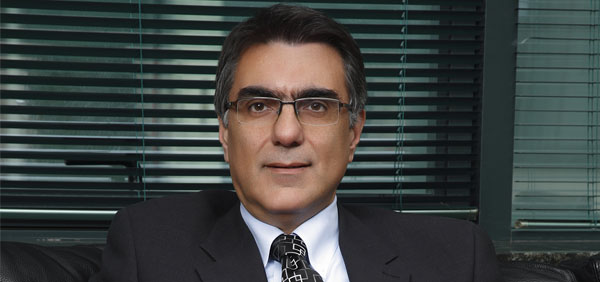American Consumers' Choice: Natural Stones of Turkey
 According to Business Monitor International forecasts, the mining industry in Turkey is expected to grow by 71.3% between 2009 and 2013. The industry is expected to reach a value of US $12.76 billion by 2013. Currently there are 20-25 mining companies from Canada, the U.S., the UK and Australia operating in Turkey.
According to Business Monitor International forecasts, the mining industry in Turkey is expected to grow by 71.3% between 2009 and 2013. The industry is expected to reach a value of US $12.76 billion by 2013. Currently there are 20-25 mining companies from Canada, the U.S., the UK and Australia operating in Turkey. The experience that they bring and the relationships formed with local companies are in turn enhancing the mining industry and transforming Turkey into a notable mining nation. The US market reached up to $400 million in exports from Turkey, but dropped approximately 30% after the economic crisis.
Mehmet Özer is the President of Istanbul Mineral Exporters’ Association since April 2010. Erdogan Akbulak, board members of Istanbul Mineral Exporters’ Association and Chairman of Silkar Madencilik San. ve Tic. A.Ş., one of Turkey’s leading companies in natural stone industry serving with a variety of products including granite, marble, antiqued stones and mosaics, answered TURKOFAMERICA’s questions.
The U.S. is the leading market in a list of 10 countries and imports 10 different mining products from Turkey. What is the primary reason for this?
When you compare the export statistics of Turkey to the U.S., especially in the mining sector, it is apparent that almost more than 80% is natural stones; marbles and travertines respectively. The reason is that Turkey has ample reserves and a large production capacity for finished products of good quality. In past years, before the economic crisis, there was steady and remarkable growth in the U.S. market that enabled Turkish manufacturers to invest more in production by increasing their capacity and the variety of their offerings. In fact, Turkey owns a large portion of the world’s calcareous stone reserves, and with vertical integration, has contributed to a good quality/price ratio for finished products, especially in tile and slab formats. The variety of offered products combined with inexpensive pricing gives even ordinary Americans affordable options to buy natural stones, although one might think such stones should be more expensive than other covering materials. Many of these materials could also be available in home improvement centers. Therefore, the penetration of Turkish stones is increasing and American consumers are getting access to top quality products as the economies of scale applies.

Why are Turkish stones less expensive than other countries’ products in the U.S. market?
One of the reasons Turkish stones are less expensive than other countries’ products, such as those of Italy, Spain and Greece, is that there are hundreds of manufacturers in Turkey producing similar products who are all in direct competition with each other. Product affordability seems good for the end-users, but it’s also essential to combine affordability with product variety, design and innovative offerings to differentiate ourselves in the market from other competitors. This approach will drive and increase brand awareness of Turkish materials in the long run.
What did you learn from the financial economic crisis?
The U.S. market reached up to $400 million in exports from Turkey, but dropped approximately 30% after the economic crisis. Even given the economic recovery, it appears that exports will take several years and beyond to reach the same figures; however, we believe that Turkey still can increase U.S. sales and will be able to introduce new materials into the market. The recession forced Turkey to enter new markets that resulted in an increased market share in the Far East. With China’s increasing demand for Turkish marbles and travertines, the Turkish stone industry was able to open hundreds of new quarries and increase the sale of raw materials to China, Taiwan, India and other countries. Obviously, this will contribute to introducing new Turkish processed stone materials into the U.S. market. In fact, the Turkish construction industry is very active in North Africa, the Gulf Area, Russia and the CIS countries, and became the second largest industry worldwide. During this recession, we also learned how to better meet the requirements of contractors for commercial projects, provided installation services for the ultimate satisfaction of the customer, and became their solution partner.
What is your expectation for the mining industry in next few years? What could the industry do in the U.S. market to increase market share?
As previously mentioned, Turkey must invest in affordability, design and innovation to drive awareness and strengthen the Turkish brands to compete with other countries. As natural stone is a green product itself, we believe there are increasing opportunities and potential for our materials to reach farther in both the U.S. market and worldwide through large U.S. architectural firms. These large firms specify materials for massive projects with environmental sensitivity in mind. It should be our responsibility to keep them informed about the development and progress of the Turkish stone industry combined with building confidence in our abilities among the developers, architects and manufacturers. Thus, Turkey can obtain a large portion of orders for stone materials in prestigious and large commercial projects that would result in the Turkish stone industry increasing its market share and becoming a world leader.
MINERAL EXPORTS’ STATISTICS
Years Minerals' Exports ($) Change (%) Share of Metal Exports in Turkey's
Total Exports (%)
1992 335.400.000 - 2.28
1993 301.600.000 -10.07 1.96
1994 376.100.000 24.70 2.07
1995 563.000.000 49.69 2.60
1996 541.600.000 -3.80 2.28
1997 596.729.725 10.17 2.17
1998 531.651.983 -10.91 1.97
1999 577.464.276 8.74 2.17
2000 568.945.463 -1.45 2.05
2001 574.882.846 0.89 1.83
2002 684,659,766 19.26 1.95
2003 847,249,000 23.96 1.81
2004 1.207.714.995 42.54 2.00
2005 1.525.279.014 26.29 2.06
2006 2.080.719.636 36.43 2.43
2007 2.715.484.019 30.52 2.56
2008 3.241.019.283 19.98 2.55
2009 2.445.365.830 -24.55 2.47
Mehmet Özer is the President of Istanbul Mineral Exporters’ Association since April 2010. Erdogan Akbulak, board members of Istanbul Mineral Exporters’ Association and Chairman of Silkar Madencilik San. ve Tic. A.Ş., one of Turkey’s leading companies in natural stone industry serving with a variety of products including granite, marble, antiqued stones and mosaics, answered TURKOFAMERICA’s questions.
The U.S. is the leading market in a list of 10 countries and imports 10 different mining products from Turkey. What is the primary reason for this?
When you compare the export statistics of Turkey to the U.S., especially in the mining sector, it is apparent that almost more than 80% is natural stones; marbles and travertines respectively. The reason is that Turkey has ample reserves and a large production capacity for finished products of good quality. In past years, before the economic crisis, there was steady and remarkable growth in the U.S. market that enabled Turkish manufacturers to invest more in production by increasing their capacity and the variety of their offerings. In fact, Turkey owns a large portion of the world’s calcareous stone reserves, and with vertical integration, has contributed to a good quality/price ratio for finished products, especially in tile and slab formats. The variety of offered products combined with inexpensive pricing gives even ordinary Americans affordable options to buy natural stones, although one might think such stones should be more expensive than other covering materials. Many of these materials could also be available in home improvement centers. Therefore, the penetration of Turkish stones is increasing and American consumers are getting access to top quality products as the economies of scale applies.

Why are Turkish stones less expensive than other countries’ products in the U.S. market?
One of the reasons Turkish stones are less expensive than other countries’ products, such as those of Italy, Spain and Greece, is that there are hundreds of manufacturers in Turkey producing similar products who are all in direct competition with each other. Product affordability seems good for the end-users, but it’s also essential to combine affordability with product variety, design and innovative offerings to differentiate ourselves in the market from other competitors. This approach will drive and increase brand awareness of Turkish materials in the long run.
What did you learn from the financial economic crisis?
The U.S. market reached up to $400 million in exports from Turkey, but dropped approximately 30% after the economic crisis. Even given the economic recovery, it appears that exports will take several years and beyond to reach the same figures; however, we believe that Turkey still can increase U.S. sales and will be able to introduce new materials into the market. The recession forced Turkey to enter new markets that resulted in an increased market share in the Far East. With China’s increasing demand for Turkish marbles and travertines, the Turkish stone industry was able to open hundreds of new quarries and increase the sale of raw materials to China, Taiwan, India and other countries. Obviously, this will contribute to introducing new Turkish processed stone materials into the U.S. market. In fact, the Turkish construction industry is very active in North Africa, the Gulf Area, Russia and the CIS countries, and became the second largest industry worldwide. During this recession, we also learned how to better meet the requirements of contractors for commercial projects, provided installation services for the ultimate satisfaction of the customer, and became their solution partner.
What is your expectation for the mining industry in next few years? What could the industry do in the U.S. market to increase market share?
As previously mentioned, Turkey must invest in affordability, design and innovation to drive awareness and strengthen the Turkish brands to compete with other countries. As natural stone is a green product itself, we believe there are increasing opportunities and potential for our materials to reach farther in both the U.S. market and worldwide through large U.S. architectural firms. These large firms specify materials for massive projects with environmental sensitivity in mind. It should be our responsibility to keep them informed about the development and progress of the Turkish stone industry combined with building confidence in our abilities among the developers, architects and manufacturers. Thus, Turkey can obtain a large portion of orders for stone materials in prestigious and large commercial projects that would result in the Turkish stone industry increasing its market share and becoming a world leader.
MINERAL EXPORTS’ STATISTICS
Years Minerals' Exports ($) Change (%) Share of Metal Exports in Turkey's
Total Exports (%)
1992 335.400.000 - 2.28
1993 301.600.000 -10.07 1.96
1994 376.100.000 24.70 2.07
1995 563.000.000 49.69 2.60
1996 541.600.000 -3.80 2.28
1997 596.729.725 10.17 2.17
1998 531.651.983 -10.91 1.97
1999 577.464.276 8.74 2.17
2000 568.945.463 -1.45 2.05
2001 574.882.846 0.89 1.83
2002 684,659,766 19.26 1.95
2003 847,249,000 23.96 1.81
2004 1.207.714.995 42.54 2.00
2005 1.525.279.014 26.29 2.06
2006 2.080.719.636 36.43 2.43
2007 2.715.484.019 30.52 2.56
2008 3.241.019.283 19.98 2.55
2009 2.445.365.830 -24.55 2.47
Last modified onSaturday, 06 May 2017 10:07
Latest from Admin TOA
- Fat Sal’s Italian Specialties Welcomes Customers in Bayville, NJ with a Renewed Concept
- FFD Wood LLC Delivers Custom Woodwork Solutions from Long Island
- A Tax Expert in the U.S. Tax World: An Interview with Samet Oynamıs
- Announcing the 2025 Edition of the 100 Most Influential Turkish Americans
- CEO Club New York Networking Night Stands Out with the Lamborghini Experience









